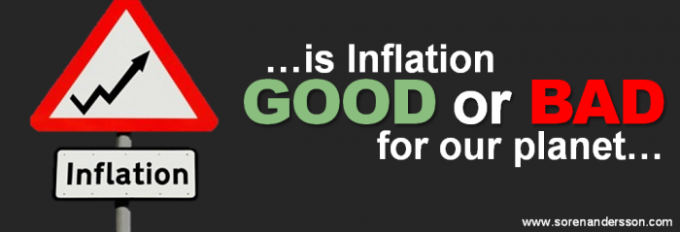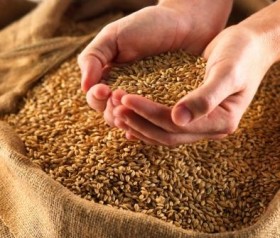
The other day I read in an article that IMF chief Christine Lagarde urged the euro zone to “fight persistently low inflation”. This made me curious about Inflation, why is it so important that we actually should “fight for it” – what do I really know about it, and how does it fit with a Sustainable Future?
Having done some research, enriching my own very modest knowledge on the subject, I realize that inflation is a very complex issue – I doubt if anyone can really see or understand the “full picture”… On the other hand, there are many people hearing the word “Inflation” every day or even carelessly using it, without ever reflecting on its full implication…
Some reflections on this topic, and a few others…
Inflation Basics…
 Inflation – When each unit of currency buys fewer goods and services.
Inflation – When each unit of currency buys fewer goods and services.
“…inflation occurs when the money supply is increasing faster than the supply of goods and services (or when the supply of goods and services decreases faster than the money supply) – consequently, inflation reflects a reduction in the purchasing power per unit of money, a loss of real value in the medium of exchange and unit of account within the economy…”
So – Inflation reduces my purchasing power – that’s why Ms. Lagarde wants us to fight it… but wait a second, she said that the euro zone should fight “persistently low inflation”… we need to understand this a little better…
A bit more context
Inflation is connected to a lot of other parameters in our economy, other than purchasing power – such as consumption patterns and costs related to debts…

If your money loses real value over time, you are probably more keen to use them while they still are worth more – which suggests that consumption will increase “now”. This is especially true about consumption that comes “on top” of our basic physical needs.
If your money keeps its value you are probably not in the same rush to use them and consumption will then level out closer to your actual “physical” needs.

A debt created today will, with high inflation, be cheaper to repay in a couple of years – the monetary value of the original debt will decrease over time compared to real value, the same way money loses value. This could also be a trigger to increased debt-financed consumption “now”.
With no inflation or even deflation – the monetary value of an original debt will remain or even increase over time compared to real value, a debt will therefore become comparatively more expensive to repay. In the same way value of saving money in the Bank would increase over time.
The effects from inflation, on debt, is then of course amended to some extent by interest-rates etc, but still, more inflation is likely to trigger more debt-creation, the same way it promotes increased consumption.
Probably these “relationships” between Inflation and Consumption was the main “driver” behind Ms. Lagarde’s comment – the Drive for Infinite Growth…
“Redistribution” of wealth…
Another effect related to inflation is the Redistribution of wealth – or maybe “Re” is the wrong prefix to use in a Society where according to a report from Oxfam issued at the World Economic Forum in Davos – the “85 richest people are as wealthy as poorest half of the world”…

More Inflation means that people who only rely on their wage as income gets reduced purchasing power – at least until the next rise in salary (if any).
If your income instead is generated by financial transactions – owning, buying and selling shares, commodities, property, land etc. – more inflation doesn’t affect you, it can even “increase” your purchasing power.
I.e. “Invest money in a piece of land in prime location – a couple of years later the next buyer of the land will automatically have to pay more money, since the purchasing power per unit of money have decreased… and this is without even considering whether the value of the piece of land has increased due to other circumstances…”
Owning “real value” is a way to protect yourself from the effects of Inflation.
Now – take a look at ownership in your part of society or in our global society – is it concentrated in the rich end or the poor end of the “scale”… and where are people relying only on their wage “located” on the same “scale”…
From Demand-driven to Supply-driven economy…
Recently I read an article by Lester R. Brown in “Grist” focusing on import and export of Grain.
Some quotes from this “must-read” article:
“…Overnight, China has become a leading world grain importer, set to buy a staggering 22 million tons in the 2013-14 trade year, according to the latest U.S. Department of Agriculture projections. As recently as 2006 – just eight years ago – China had a grain surplus and was exporting 10 million tons…”
 “…Since 2006, China’s grain use has been climbing by 17 million tons per year. For perspective, this compares with Australia’s annual wheat harvest of 24 million tons. With population growth slowing, this rise in grain use is largely the result of China’s huge population moving up the food chain and consuming more grain-based meat, milk, and eggs…”
“…Since 2006, China’s grain use has been climbing by 17 million tons per year. For perspective, this compares with Australia’s annual wheat harvest of 24 million tons. With population growth slowing, this rise in grain use is largely the result of China’s huge population moving up the food chain and consuming more grain-based meat, milk, and eggs…”
“…China is not alone in the scramble for food. An estimated 2 billion people in other countries are also moving up the food chain, consuming more grain-intensive livestock products. The combination of population growth, rising affluence, and the conversion of one third of the U.S. grain harvest into ethanol to fuel cars is expanding the world demand for grain by a record 43 million tons per year, double the annual growth of a decade ago…”
This is only one example of how the world quickly, and right now, is transitioning from an era of abundance to one dominated by scarcity – from a demand-driven economy to a supply-driven…
… put the facts from Mr Browns article together with the “promise” from the Airline-industry to decrease their emissions “largely with the help of biofuels” – referred to in one of my previous articles – and questions do arise; “is high-income peoples air-travel going to be prioritized over low-income families, trapped by food price inflation, unable to afford enough food to eat every day…”
So… is Inflation a “threat” to Sustainability…
Within 3-4 decades there will be 2 Billion more people on this planet according to latest UN predictions, while at the same time 2-3 Billion will rise from poverty – anyone believing that we can scale up and continue exploiting the planet the way we are doing currently – needs to rethink… and needs to do so urgently.
In the “developed parts” of our Society, consumption levels are way beyond sustainable levels – any financial “instrument” or indicator pushing the consumption level in these parts even higher is devastating to our survival on this planet, instead we need “tools” to bring consumption down to a sustainable level, while at the same time, undeveloped and developing parts of our society need to get out of poverty so that people can fulfil their basic needs.
If leading politicians, economists, bankers and executives in the world fail to recognize that we are in trouble and instead try to use “Carrots and Sticks” to reach inflation-goals set, according to old flawed economic models, to increase demand in a world already consuming beyond sustainable levels and where scarcity is looming…